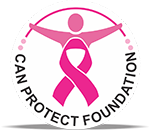A mammogram is an X-ray image of the breast. Doctors use a mammogram to search for early signs of breast cancer.
Regular mammograms are the most effective tests doctors have to find breast cancer early, in some cases up to three years before it can be felt. When their breast cancer is identified early, a lot of women go on to live long and healthy lives.
When should I get a mammogram?
The Can Protect Foundation advises that women should have mammograms every two years from age 50 to 74 years. Speak to your health professional if you have any signs or changes in your breast, or if breast cancer runs in your family. He or she may suggest that you have mammograms before age 50 or more frequently than usual.
Are you worried about the cost? CDC offers free or low-cost mammograms. Find out if you qualify.
How is a mammogram done?
You will take a position in front of a specific X-ray machine. A technologist will place your breast on a clear plastic plate. One more plate will firmly press your breast from above. The plates will flatten the breast, keeping it still when the X-ray is being taken. You will experience some pressure. The other breast will be X-rayed in the similar way. The actions are then repeated to make a side view of each breast. You will then wait around while the technologist inspections the four X-rays to make sure the images do not need to be re-done. Keep in mind that the technologist cannot tell you the results of your mammogram.
What does having a mammogram experience like?
Having a mammogram is not comfortable for most women. Some women discover it painful. A mammogram will take only a few moments, though, and the pain is over soon. What you experience depends on the expertise of the technologist, the size of your breasts, and how much they require to be pressed. Your breasts may be more sensitive if you are about to get or have your period. A doctor with exclusive training, called a radiologist, will read the mammogram. He or she will look at the X-ray for early signs of breast cancer or other problems.
When will I get the results of my mammogram?
You will generally get the results within just a few weeks, despite the fact that it depends on the facility. A radiologist reads your mammogram and then reports the results to you or your doctor.
What happens if my mammogram is normal?
Proceed to get regular mammograms. Mammograms perform best when they can be compared with earlier ones. This enables your doctor to evaluate them to look for changes in your breasts.
What happens if my mammogram is abnormal?
If it is unusual, do not freak out. An irregular mammogram does not always mean that there is cancer. But you will need to have extra mammograms, tests, or exams before the doctor can tell for sure. You may also be known to a breast specialist or a surgeon. It does not actually mean you have cancer or need surgery. These doctors are specialists in diagnosing breast problems.
Where can I get a mammogram and who can I talk to if I have questions?
If you have a regular doctor, talk to him or her.
Call the Can Protect Foundation at ……….
Can Protect Foundation’s Breast and Cervical Cancer Early Detection Program carry out regular camps and facilities to provide low-cost or free mammograms to women who qualify. Find out if you qualify.
[iconbox title=”Suggestions for Getting a Mammogram” style=”top_icon_circle” icon_color=”#f4cbdf” icon_bg_color=”#ffa7d1″ icon_bor_color=”#ff429d” iconbox_bg_color=”#ffcee1″ text_align=”left” frame=”framed_when_hover”]
- Try not to have your mammogram the week prior to you get your period or in the course of your period. Your breasts may be tender or swollen then.
- On the day of your mammogram, don’t wear deodorant, perfume, or powder. These products can show up as white spots on the X-ray.
- Some women prefer to wear a top with a skirt or pants, instead of a dress. You will need to undress from your waist up for the mammogram.
